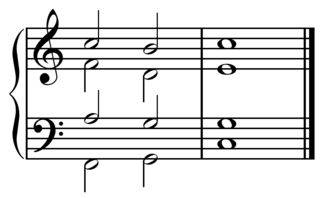Additive synthesis is a sound synthesis technique that creates timbre by adding sine waves together.

The fundamental frequency, often referred to simply as the fundamental, is defined as the lowest frequency of a periodic waveform. In music, the fundamental is the musical pitch of a note that is perceived as the lowest partial present. In terms of a superposition of sinusoids, the fundamental frequency is the lowest frequency sinusoidal in the sum of harmonically related frequencies, or the frequency of the difference between adjacent frequencies. In some contexts, the fundamental is usually abbreviated as f0, indicating the lowest frequency counting from zero. In other contexts, it is more common to abbreviate it as f1, the first harmonic.

A harmonic series is the sequence of harmonics, musical tones, or pure tones whose frequency is an integer multiple of a fundamental frequency.

In music, harmony is the concept of combining different sounds together in order to create new, distinct musical ideas. Theories of harmony seek to describe or explain the effects created by distinct pitches or tones coinciding with one another; harmonic objects such as chords, textures and tonalities are identified, defined, and categorized in the development of these theories. Harmony is broadly understood to involve both a "vertical" dimension (frequency-space) and a "horizontal" dimension (time-space), and often overlaps with related musical concepts such as melody, timbre, and form.

In music, timbre, also known as tone color or tone quality, is the perceived sound quality of a musical note, sound or tone. Timbre distinguishes different types of sound production, such as choir voices and musical instruments. It also enables listeners to distinguish different instruments in the same category.

Pitch is a perceptual property that allows sounds to be ordered on a frequency-related scale, or more commonly, pitch is the quality that makes it possible to judge sounds as "higher" and "lower" in the sense associated with musical melodies. Pitch is a major auditory attribute of musical tones, along with duration, loudness, and timbre.

A combination tone is a psychoacoustic phenomenon of an additional tone or tones that are artificially perceived when two real tones are sounded at the same time. Their discovery is credited to the violinist Giuseppe Tartini and so they are also called Tartini tones.

Tonality is the arrangement of pitches and/or chords of a musical work in a hierarchy of perceived relations, stabilities, attractions, and directionality. In this hierarchy the single pitch or triad with the greatest stability is called the tonic. The root of the tonic triad forms the name given to the key, so in the key of C major the tone C can be both the tonic of the scale and the root of the tonic triad. The tonic can be a different tone in the same scale, when the work is said to be in one of the modes of the scale.
A movement is a self-contained part of a musical composition or musical form. While individual or selected movements from a composition are sometimes performed separately as stand-alone pieces, a performance of the complete work requires all the movements to be performed in succession. A movement is a section, "a major structural unit perceived as the result of the coincidence of relatively large numbers of structural phenomena".
A unit of a larger work that may stand by itself as a complete composition. Such divisions are usually self-contained. Most often the sequence of movements is arranged fast-slow-fast or in some other order that provides contrast.
While the ultimate harmonic goal of a tonal composition is the final tonic triad, there will also be many interior harmonic goals found within the piece, some of them tonic triads and some of them not. ...We use the term cadence to mean a harmonic goal, specifically the chords used at the goal.
Sonata form is one of the most influential ideas in the history of Western classical music. Since the establishment of the practice by composers like C.P.E. Bach, Haydn, Mozart, Beethoven, and Schubert and the codification of this practice into teaching and theory, the practice of writing works in sonata form has changed considerably.

Harmonice Mundi (Harmonices mundi libri V) (Latin: The Harmony of the World, 1619) is a book by Johannes Kepler. In the work, written entirely in Latin, Kepler discusses harmony and congruence in geometrical forms and physical phenomena. The final section of the work relates his discovery of the so-called third law of planetary motion.
Musical acoustics or music acoustics is a multidisciplinary field that combines knowledge from physics, psychophysics, organology, physiology, music theory, ethnomusicology, signal processing and instrument building, among other disciplines. As a branch of acoustics, it is concerned with researching and describing the physics of music – how sounds are employed to make music. Examples of areas of study are the function of musical instruments, the human voice, computer analysis of melody, and in the clinical use of music in music therapy.

In music, consonance and dissonance are categorizations of simultaneous or successive sounds. Within the Western tradition, some listeners associate consonance with sweetness, pleasantness, and acceptability, and dissonance with harshness, unpleasantness, or unacceptability, although there is broad acknowledgement that this depends also on familiarity and musical expertise. The terms form a structural dichotomy in which they define each other by mutual exclusion: a consonance is what is not dissonant, and a dissonance is what is not consonant. However, a finer consideration shows that the distinction forms a gradation, from the most consonant to the most dissonant. In casual discourse, as German composer and music theorist Paul Hindemith stressed, "The two concepts have never been completely explained, and for a thousand years the definitions have varied". The term sonance has been proposed to encompass or refer indistinctly to the terms consonance and dissonance.
In music, 72 equal temperament, called twelfth-tone, 72-TET, 72-EDO, or 72-ET, is the tempered scale derived by dividing the octave into twelfth-tones, or in other words 72 equal steps. Each step represents a frequency ratio of 72√2, or 16+2⁄3 cents, which divides the 100 cent "halftone" into 6 equal parts and is thus a "twelfth-tone". Since 72 is divisible by 1, 2, 3, 4, 6, 8, 9, 12, 18, 24, 36, and 72, 72-EDO includes all those equal temperaments. Since it contains so many temperaments, 72-EDO contains at the same time tempered semitones, third-tones, quartertones and sixth-tones, which makes it a very versatile temperament.

In music, the bore of a wind instrument is its interior chamber. This defines a flow path through which air travels, which is set into vibration to produce sounds. The shape of the bore has a strong influence on the instrument's timbre.
A contrafact is a musical work based on a prior work. The term comes from classical music and has only since the 1940s been applied to jazz, where it is still not standard. In classical music, contrafacts have been used as early as the parody mass and In Nomine of the 16th century. More recently, Cheap Imitation (1969) by John Cage was produced by systematically changing notes from the melody line of Socrate by Erik Satie using chance procedures.

Diatonic and chromatic are terms in music theory that are used to characterize scales. The terms are also applied to musical instruments, intervals, chords, notes, musical styles, and kinds of harmony. They are very often used as a pair, especially when applied to contrasting features of the common practice music of the period 1600–1900.
Mortuos Plango, Vivos Voco for eight-track tape is a musical composition created in 1980 by Jonathan Harvey, with the assistance of Stanley Haynes and Xavier Rodet, commissioned by the Centre Georges Pompidou in Paris. The two sounds contrasted are the tenor bell at Winchester Cathedral, England and the voice of the composer's son Dominic, at the time a chorister there, both recorded by John Whiting. The text is taken from that written on the bell: Horas Avolantes Numero, Mortuos Plango: Vivos ad Preces Voco. Music V was used to analyze and transform the sounds.
Musicology commonly classifies scales as either hemitonic or anhemitonic. Hemitonic scales contain one or more semitones, while anhemitonic scales do not contain semitones. For example, in traditional Japanese music, the anhemitonic yo scale is contrasted with the hemitonic in scale. The simplest and most commonly used scale in the world is the atritonic anhemitonic "major" pentatonic scale. The whole tone scale is also anhemitonic.

György Ligeti composed his Viola Sonata between 1991 and 1994. It is a sonata for viola solo in six movements, and Ligeti composed it in various phases, parallel with his Violin Concerto, and his piano études. The composer was inspired to write a viola sonata after hearing Tabea Zimmermann playing on the radio, then began writing various movements. The second movement Loop, was premiered by Garth Knox, while Facsar was premiered in 1993 by Jürg Dahler. The two movements were conceived as part of a complete work and they became the second and third movements of Ligeti's Viola Sonata.










